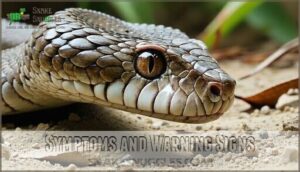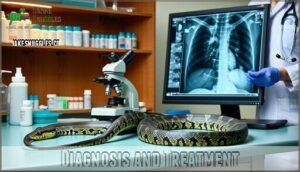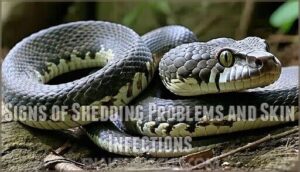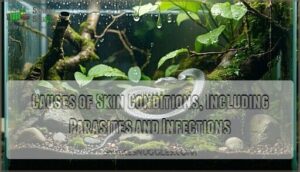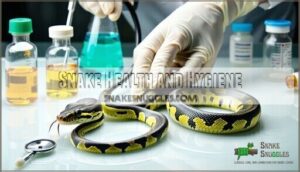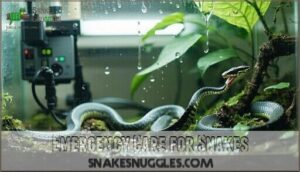This site is supported by our readers. We may earn a commission, at no cost to you, if you purchase through links.

Physical red flags include mouth rot, skin blisters, mites, or changes in body shape.
Don’t wait if you notice respiratory distress, regurgitation after feeding, or abnormal discharge from the mouth or nose.
Your snake’s behavior tells a story – sudden aggression, excessive hiding, or loss of muscle tone signal trouble.
Snake health when to seek professional help isn’t always obvious, but trust your instincts when something feels off.
The subtle signs often reveal the most about what’s brewing beneath those scales, and it’s crucial to identify these signs to ensure your snake’s health and well-being, especially when you notice respiratory distress or regurgitation.
Table Of Contents
- Key Takeaways
- Recognizing Unhealthy Snakes
- Snake Health Signs Requiring Veterinary Care
- Snake Diseases and Conditions
- Respiratory Infections in Snakes
- Snake Shedding and Skin Conditions
- Common Snake Health Issues
- Snake Behavior and Health
- Snake Health and Hygiene
- Snake Veterinary Care
- Emergency Care for Snakes
- Frequently Asked Questions (FAQs)
- How can I tell if my snake is sick?
- What are some specific symptoms of common illnesses in snakes?
- Why is shedding a concern for snake health?
- What are some signs of respiratory problems in snakes?
- What are some behavioral changes that may indicate snake illness?
- When should I seek veterinary care for my snake?
- What are the five things you should not do when caring for snake bites?
- What is the proper care for a patient suffering from a snake bite?
- Does urgent care treat snake bites?
- How long can you survive a rattlesnake bite without treatment?
- Conclusion
Key Takeaways
- Watch for respiratory warning signs – Don’t ignore wheezing, open-mouth breathing, or labored respiration, as these indicate serious infections that can quickly become life-threatening without immediate veterinary care.
- Trust your instincts about behavioral changes – If your snake shows unusual lethargy, stops eating for more than two feeding cycles, or displays abnormal hiding patterns, these often signal underlying health issues before physical symptoms appear.
- Take skin and shedding problems seriously – Scale rot, stuck shed pieces, blisters, or unusual lumps aren’t cosmetic issues—they’re signs of infections or parasites that need professional treatment to prevent serious complications.
- Act quickly during emergencies – Symptoms like regurgitation, mouth discharge, difficulty swallowing, or sudden collapse require immediate veterinary attention since snake health problems can escalate rapidly without proper medical intervention.
Recognizing Unhealthy Snakes
Looking at your snake’s daily routine can reveal important health clues that many owners overlook.
You’ll want to watch for subtle changes in appetite, behavior, physical appearance, and waste patterns that often signal the need for professional veterinary care.
Changes in Appetite and Feeding Patterns
When your snake suddenly refuses food, it’s signaling potential trouble ahead.
Appetite changes aren’t just finicky behavior—they often indicate underlying stress or health issues that need attention.
While occasional food refusal happens naturally, persistent feeding problems warrant professional evaluation.
Watch for these warning signs:
- Complete food refusal lasting more than two feeding cycles
- Sudden appetite loss in previously reliable eaters
- Eating habits becoming irregular or erratic
- Nutrition deficits from prolonged feeding issues
Unusual Behavior and Lethargy
When your slithery companion becomes a couch-potato reptile, it’s time to pay attention. Unusual behavior and lethargy often signal underlying health issues that shouldn’t be ignored.
| Behavioral Changes | Stress Factors | Activity Levels |
|---|---|---|
| Excessive hiding behavior | Temperature fluctuations | Reduced movement patterns |
| Aggression or withdrawal | Improper humidity levels | Unresponsiveness to stimuli |
| Abnormal positioning | Environmental disturbances | Prolonged inactivity |
Unexplained lethargy isn’t just sleepiness—it’s your snake’s way of waving a red flag. Snake behavior issues like refusing handling or staying motionless for days indicate something’s wrong.
Recognizing signs of illness is vital for providing proper care and preventing serious health problems.
Physical Symptoms and Abnormal Shedding
Your pet’s skin tells a story about their health.
Watch for these warning signs:
- Shedding issues – stuck skin pieces or infrequent molts
- Skin lesions – blisters, discoloration, or scale rot patches
- Physical symptoms – swelling, lumps, or abnormal coloration
- Respiratory problems – wheezing or labored breathing
These signs of illness need veterinary attention to prevent serious snake health issues from developing.
Changes in Stool and Urine Patterns
Vigilance makes all the difference when monitoring your snake’s waste patterns.
Changes in stool and urine patterns often signal digestive issues or underlying snake health issues requiring reptile veterinary help.
Watch for these stool abnormalities and signs of illness:
- Foul odor or unusual consistency – indicates potential bacterial infections
- Visible parasites or blood – demands immediate parasite detection and fecal analysis
- Frequency changes – too often or infrequent suggests digestive problems
- Color variations – abnormal hues warrant urine testing and veterinary evaluation
Snake Health Signs Requiring Veterinary Care
Some snake health problems need a vet’s immediate attention to prevent serious complications or death.
You’ll want to recognize these critical warning signs so you can act quickly when your snake’s life depends on it.
Wheezing, Labored Breathing, and Respiratory Distress
Breathing problems in snakes aren’t just concerning—they’re often life-threatening emergencies. Wheezing symptoms and labored breathing signal serious respiratory infections that demand immediate veterinary attention.
Open-mouth breathing, gurgling sounds, or visible mucus indicate respiratory distress requiring urgent respiratory care. Don’t wait—these signs of respiratory failure progress quickly without professional treatment.
Snakes with respiratory issues often require respiratory health checks to identify the underlying cause of their condition.
Skin Infections, Blisters, and Shedding Problems
Several skin troubles can spell serious health problems for your snake, so don’t brush them off. Skin lesions, blisters, or shedding issues often signal infections that need professional care.
Scale rot appears as dark, soft patches on belly scales, while blister care requires immediate attention to prevent spreading.
Watch for these warning signs:
- Skin infections with red, swollen areas or discharge
- Shedding problems like retained pieces or stuck shed
- Snake skin problems including unusual bumps or discoloration
Early intervention makes all the difference in treating these conditions successfully.
Changes in Body Shape and Coloration
Your snake’s appearance tells a story – lumps, bumps, or body swelling might indicate tumors, abscesses, or parasites.
Color change and scale discoloration can signal infections or stress. Pattern alteration and texture abnormality often reveal underlying snake health problems requiring immediate attention.
| Warning Sign | Possible Cause | Action Needed |
|---|---|---|
| Unusual lumps or bumps | Tumors, abscesses, parasites | Veterinary exam within days |
| Sudden color fading | Stress, illness, poor conditions | Check husbandry, monitor closely |
| Scale texture changes | Infections, shedding issues |
Professional assessment required.
These changes in body shape and coloration aren’t fashion statements – they’re signs of illness your snake can’t voice.
Difficulty Eating and Regurgitation
When your snake suddenly refuses food or brings up meals like a boomerang, food refusal and regurgitation causes often point to serious snake digestive issues.
Eating difficulties and swallowing problems aren’t just picky behavior—they signal snake illness diagnosis needs.
Feeding issues demand immediate veterinary attention to rule out parasites, infections, or blockages affecting snake health.
Snake Diseases and Conditions
Your snake can face several serious conditions that demand immediate veterinary attention. Understanding these diseases helps you act quickly when your pet’s health is at stake.
Stomatitis (Mouth Rot) in Snakes
Bacterial mouth infections can turn your snake’s feeding time into a nightmare.
Stomatitis strikes when opportunistic bacteria like Aeromonas invade oral tissues, causing swollen, discolored gums and that telltale cheesy discharge.
Poor husbandry often sets the stage – think dirty tanks and stress.
Early intervention prevents this bacterial disease from spreading systemically, potentially saving your snake’s life.
Regular checks for reptile bacterial diseases can help identify issues before they become severe.
Viruses and Snake Diseases
When viral infections strike, your snake’s immune response becomes compromised, making them vulnerable to secondary diseases.
Snake viruses spread through contaminated environments and inadequate quarantine protocols.
Watch for persistent anorexia, weight loss, and neurological symptoms like abnormal posturing.
Diagnostic tests help identify specific viral strains.
Unfortunately, viral treatment options remain limited, focusing primarily on supportive care and preventing disease transmission to other reptiles, which is crucial for maintaining a healthy environment and preventing the spread of viral infections.
Skin Conditions, Infections, and Wounds
Beyond viral infections, your snake’s skin tells its own health story. Watch for skin lesions, unusual bumps, or discharge that signals trouble brewing. Scale rot and blister treatment needs prompt attention before infection control becomes a bigger headache.
Key warning signs include:
- Open wounds or cuts that won’t heal
- Dark, musty-smelling patches (scale rot)
- Fluid-filled blisters or swelling
- Skin problems during normal snake skin shedding cycles
Parasitic Infections, Including Internal Parasites and Mites
When tiny invaders infiltrate your snake’s world, Mite Infestations and Internal Parasites become serious threats requiring immediate attention.
Identifying Parasites Early prevents devastating health consequences.
Snake Mites appear as tiny moving specks, causing excessive scratching and skin irritation.
Intestinal Worms trigger weight loss despite normal eating habits.
Watch for lethargy, poor appetite, and abnormal stools—telltale signs of parasitic infections.
Snake Parasite Control demands professional veterinary intervention.
Don’t attempt home remedies that might worsen conditions.
Parasite Control strategies include thorough enclosure sanitization and quarantine protocols for new animals.
Respiratory Infections in Snakes
Respiratory infections represent one of the most common and dangerous health issues your snake can face, often developing from improper humidity levels or environmental stress.
You’ll need to act quickly when you spot the warning signs, as these infections can rapidly progress from mild discomfort to life-threatening respiratory failure, which can be a result of respiratory issues.
Causes and Risk Factors
Environmental stress tops the list for respiratory infections in your pet snake.
Poor hygiene, inadequate temperature, and handling errors create perfect conditions for illness.
Your snake’s genetic predisposition and age also matter.
Key risk factors include:
- Inadequate humidity (below 50-60% for most species)
- Poor nutrition leading to weakened immunity
- Environmental stress from temperature fluctuations
- Handling errors during cleaning or feeding
Symptoms and Warning Signs
Several key breathing issues demand immediate attention when they appear in your snake.
Wheezing, open-mouth breathing, and labored respiration signal serious respiratory problems.
Appetite changes and weight loss often accompany these signs of illness.
Lethargy signs include reduced movement and unresponsiveness.
Watch for nasal discharge, excess mouth mucus, and skin lesions around respiratory areas—these snake disease symptoms indicate when to seek professional help immediately.
Diagnosis and Treatment
When you’ve identified snake respiratory symptoms, getting professional snake care is your next move.
Your vet will use diagnostic tools to pinpoint the issue and create effective treatment plans.
Medical testing typically includes:
- X-rays – Reveal lung inflammation and fluid buildup
- Bacterial cultures – Identify specific pathogens causing infection
- Blood work – Check overall health screening markers
Veterinary guidance guarantees proper antibiotics or antifungals target the exact problem.
Early intervention means excellent recovery odds for your snake.
Prevention and Management
Now you can prevent respiratory infections and manage your snake’s health effectively. Disease Prevention starts with maintaining ideal humidity levels and spotless enclosures. Environmental Care includes temperature gradients and proper ventilation.
Health Monitoring through regular checkups guarantees early detection. Stress Management involves minimizing handling during illness. Snake Nutrition supports immune function.
| Prevention Factor | Target Range | Management Tips |
|---|---|---|
| Humidity | 50-80% | Use hygrometers, water bowls |
| Temperature | 75-90°F gradient | Heat pads, thermostats |
| Cleanliness | Weekly deep clean | Spot clean daily |
| Stress Level | Minimal handling | Secure hides, quiet environment |
| Veterinary Care | Annual checkups | Find reptile specialist |
Preventive care beats treatment every time.
Snake Shedding and Skin Conditions
Your snake’s shedding process reveals essential health information that you shouldn’t ignore.
Problems like stuck shed, retained eye caps, or unusual skin changes often signal underlying issues requiring professional veterinary attention.
Healthy Shedding Patterns
Your snake’s shedding cycles reveal important health insights.
Healthy shedding patterns show these key signs:
- Complete single-piece shed – skin comes off in one continuous piece every 4-8 weeks
- Pre-shed indicators – milky eyes and dull coloration appear 7-10 days before shedding
- Fresh appearance – vibrant colors and clear scales emerge after successful molts
Monitor these shedding tips closely, as molt issues can indicate underlying skin health problems requiring attention.
Signs of Shedding Problems and Skin Infections
Watch out for telltale signs when your snake’s shedding goes sideways.
Normal shed cycles turn problematic when you spot trouble brewing.
- Dysecdysis (stuck shed) – Retained skin patches clinging like stubborn bandages, especially around eyes and tail tips
- Scale rot – Dark, discolored scales with underlying tissue damage from bacterial infections
- Skin lesions – Raised bumps, blisters, or wounds indicating infection or parasite activity
- Blister care needs – Fluid-filled pockets requiring immediate attention to prevent systemic illness
These shedding issues signal deeper problems requiring professional snake health checks.
Causes of Skin Conditions, Including Parasites and Infections
Poor husbandry creates perfect conditions for skin infections.
Up to 80% of captive snake skin problems stem from dirty enclosures, wrong humidity levels, or temperature issues.
Bacterial infections like scale rot thrive in wet, contaminated bedding.
Fungal diseases flourish when humidity’s off.
Snake mites cause parasites that lead to dermatitis and secondary infections.
Parasite control and proper environmental management prevent most skin conditions requiring veterinary care.
Treatment and Prevention Strategies
When skin conditions threaten your snake’s health, preventive care is your best defense.
Maintain excellent hygiene, quarantine new arrivals, and control stress through ideal habitat conditions.
Balanced nutrition supports natural disease management.
Regular health monitoring catches issues early.
For persistent problems requiring professional help, consult reptile veterinarians who offer specialized treatment options and veterinary guidance for thorough snake health.
Common Snake Health Issues
Snake owners face three major health challenges that can quickly turn serious without proper attention.
Internal parasites like worms steal nutrients, while mites create itchy misery, respiratory infections cause wheezing that sounds like a tiny accordion, and skin problems can turn your snake’s beautiful scales into a patchy mess, including issues like respiratory infections.
Internal Parasites and Mites
Unwelcome hitchhikers can wreak havoc on your snake’s health.
Mite infestation and intestinal worms cause weight loss, lethargy, and visible skin irritation.
Snake mites appear as tiny moving dots, while internal parasites remain hidden but deadly.
Effective parasite control requires professional parasite diagnosis through fecal testing.
Don’t let these common snake parasites turn your pet into a walking buffet for unwanted guests.
Respiratory Problems and Infections
Wheezing and breathing issues are red flags you can’t ignore.
Respiratory infections in snakes spread fast, causing lung infections and airway disease.
Signs of respiratory problems in snakes include mouth gaping, excess mucus, and respiratory distress.
Tracheal problems lead to respiratory failure without prompt veterinary care.
Your quick action saves lives.
Skin Conditions and Infections
Your snake’s skin tells a story you can’t ignore.
Watch for these critical warning signs that demand immediate attention:
- Skin lesions appearing as open wounds or discolored patches
- Scale rot causing darkened, mushy scales on the belly
- Shedding issues with stuck pieces creating infection risks
- Mite infestations showing tiny moving dots and excessive scratching
These skin abnormalities often signal underlying problems requiring veterinary intervention.
Snake Behavior and Health
Your snake’s behavior changes often signal health problems before physical symptoms appear.
Watch for shifts in activity levels, hiding patterns, or feeding responses that could indicate your pet needs professional care.
Changes in Activity Patterns and Habits
Usually, your snake follows predictable daily routines.
When activity levels suddenly shift, you’re witnessing important behavioral shifts that signal trouble ahead.
| Behavior Change | Potential Health Issue |
|---|---|
| Excessive hiding | Respiratory infection |
| Unusual lethargy | Metabolic disorder |
| Changes in appetite | Parasitic infection |
| Increased aggression | Pain or discomfort |
| Disrupted daily routines | Environmental stress |
These habit changes don’t happen overnight, but lethargy signs and unusual behavior patterns often indicate underlying illness requiring veterinary attention.
Warning Signs of Health Issues
When appetite changes, lethargy signs, or unusual hiding behavior appear, your pet snake’s sending an SOS signal.
These warning signs often indicate respiratory infections, skin lesions, or other health problems requiring immediate snake veterinary help.
Weight loss and respiratory issues can escalate quickly, so don’t wait—trust your instincts when illness symptoms emerge.
Snake Health and Hygiene
You’ll prevent most snake health problems by maintaining proper hygiene and reducing environmental stress factors.
Clean enclosures, appropriate handling techniques, and consistent feeding schedules create the foundation for your snake’s long-term wellness.
Maintaining a Clean and Sanitary Environment
Three key factors create a clean environment that prevents disease and promotes ideal snake health.
Enclosure maintenance requires weekly deep cleaning and daily spot removal of waste. Choose appropriate substrate selection like paper towels or cypress mulch that won’t harbor bacteria. Water quality demands fresh changes every few days—stagnant water becomes a bacterial playground.
Sanitation protocols include:
- Replace substrate completely during monthly enclosure cleaning sessions
- Maintain proper humidity control between 50-60% to prevent respiratory issues
- Disinfect food bowls and décor with reptile-safe cleaners regularly
Your snake’s proper hygiene depends on consistent maintaining sanitary environment practices. Regular snake hygiene techniques are essential for preventing diseases and promoting a healthy environment.
Proper Handling and Restraint Techniques
Safe Handling starts with confidence—yours and your snake’s.
Support your snake’s body with both hands, never grabbing just the head or tail.
Move slowly and speak softly; snakes sense your energy.
Proper handling means letting them feel secure while you maintain control.
Restraint techniques should feel like a gentle hug, not a wrestling match.
Always wash hands before and after—it’s handling snakes 101!
Investing in proper snake handling tools is essential for safe interaction.
Feeding and Nutrition Strategies
Good handling sets the stage, but feeding your snake the right diet is equally important for ideal health.
Offer appropriately-sized prey – typically rodents that match your snake’s girth. Food quality matters; frozen-thawed prey reduces parasite risks.
Feeding schedules vary by species and age, with juveniles eating weekly and adults every 2-3 weeks.
Monitor nutrient balance and consider dietary supplements only when your vet recommends them.
Understanding proper snake food choices is vital for maintaining your snake’s overall health.
Reducing Stress and Promoting Health
Proper habitat setup isn’t enough—you need active stress management to keep your snake healthy.
Environmental enrichment and habitat optimization work together for effective stress reduction.
- Environmental Enrichment: Provide multiple hiding spots, climbing branches, and varied textures to simulate natural habitats
- Stress Management: Monitor handling frequency and maintain consistent routines for feeding and health monitoring
- Health Monitoring: Watch for behavioral changes that signal stress-related health issues requiring snake nutrition adjustments
Snake Veterinary Care
Finding the right reptile veterinarian before you need one saves precious time during health emergencies.
You’ll want to research qualified vets in your area who specialize in snake care and understand their unique medical needs.
Choosing a Reptile Veterinarian
When choosing the right reptile veterinarian for your snake, credentials matter most.
Look for vet credentials like ARAV membership and extensive reptile experience treating snakes specifically.
Check online reviews from other snake owners and verify they offer specialty care and emergency services.
Your pet snake health depends on finding someone who truly understands snake health check requirements and veterinary care protocols.
| Qualification | What to Look For | Red Flags |
|---|---|---|
| Vet Credentials | ARAV membership, DVM degree | General practice only |
| Reptile Experience | 50%+ reptile patients | Rarely treats snakes |
| Online Reviews | Positive snake owner feedback | Complaints about handling |
| Specialty Care | Advanced diagnostics available | Basic services only |
| Emergency Services | 24/7 or after-hours access | No emergency coverage |
Preparing for a Veterinary Visit
Your vet visit prep starts with secure snake transport – choose an escape-proof carrier that’ll contain your slithery Houdini.
Document your pet’s medical history and feeding schedule for the reptile veterinarian.
Prepare thoughtful vet questions about diet, behavior changes, and care concerns.
Don’t forget basic emergency kits for the journey – you’re now ready for a successful snake health check.
Common Diagnostic Tests and Procedures
Your reptile veterinarian has several diagnostic capabilities at their disposal once you arrive.
Blood tests reveal internal health issues, while fecal exams detect parasites lurking in your snake’s system.
Imaging studies like X-rays show blockages or abnormalities inside.
For complex cases, endoscopy allows direct visualization of internal structures, and biopsy procedures provide definitive tissue analysis for accurate snake disease diagnosis.
Understanding snake diagnostic tests is essential for identifying health issues in snakes.
Treatment Options and Medications
Once diagnosis confirms your snake’s condition, veterinary treatment options focus on targeted medication dosage and thorough care.
Your reptile medical aid toolkit might include antibiotic therapy for infections, pain management protocols, and wound care solutions.
Treatment approaches include:
- Antibiotic Therapy: Targets bacterial infections with species-specific medications
- Surgical Interventions: Addresses impactions, abscesses, or reproductive issues
- Pain Management: Controls discomfort during recovery phases
Following prescribed treatment options guarantees your snake’s swift return to healthy snake health.
Emergency Care for Snakes
Snake emergencies can escalate quickly, so you’ll need to recognize critical warning signs that demand immediate veterinary attention.
Quick action during respiratory distress, severe injuries, or neurological symptoms can mean the difference between life and death for your scaly companion.
Recognizing Emergency Situations
When your snake’s life hangs in the balance, recognizing severe injuries and respiratory failure becomes essential. Cardiac arrest, neurological damage, and venomous bites demand immediate action.
Understanding snake health emergency situations is vital for effective response.
| Emergency Signs | Severity Level |
|---|---|
| Open-mouth breathing, paralysis | Critical |
| Profuse bleeding, seizures | Critical |
| Sudden collapse, unresponsiveness | Life-threatening |
These signs of illness aren’t your typical pet snake problems – they’re screaming for snake emergency care.
First Aid and Immediate Care
When emergencies strike, quick thinking saves lives.
Elevate your snake’s temperature slightly to prevent shock, but avoid overheating.
For snake bites or injuries, use clean water for wound care and eye rinses.
Cover burns with sterile bandages to prevent infection.
Keep a first aid kit nearby for urgent interventions during snake emergency care situations.
Common Emergency Procedures
Handling snake emergencies requires quick thinking and proper technique.
When your pet snake faces a crisis, these procedures can be lifesaving:
- Wound Care: Apply gentle pressure with clean gauze to control bleeding
- Respiratory Aid: Position snake upright to clear airways during breathing difficulties
- Emergency Response: Contact reptile veterinarian immediately while providing supportive care
Professional help determines appropriate venom removal and advanced interventions.
Preventing Emergencies and Promoting Health
Through proper Disease Prevention and Health Monitoring, you’ll keep your pet snake thriving.
Environmental Enrichment with correct temperatures, humidity, and cleanliness prevents most snake health problems. Snake Nutrition matters too—consistent feeding schedules reduce stress.
Emergency Preparedness means knowing signs of illness and when to seek professional help. Think of it as snake insurance—small efforts now save big headaches later!
| Prevention Category | Daily Actions | Monthly Tasks | Emergency Signs | When to Call Vet |
|---|---|---|---|---|
| Environmental | Check temps/humidity | Deep clean enclosure | Respiratory distress | Labored breathing |
| Nutritional | Monitor appetite | Weigh your snake | Food refusal 2+ weeks | Persistent regurgitation |
| Behavioral | Observe activity | Handle for health check | Lethargy/hiding | Neurological symptoms |
| Physical | Spot clean waste | Examine for parasites | Abnormal shedding | Open wounds/swelling |
| Hygiene | Fresh water daily | Sanitize equipment | Mouth discharge | Preventing emergencies requires vigilance |
Frequently Asked Questions (FAQs)
How can I tell if my snake is sick?
Something’s off when your snake suddenly stops eating, becomes lethargic, or shows breathing difficulties.
Watch for unusual hiding behavior, skin discoloration, abnormal shedding, or changes in bathroom habits—these red flags signal it’s time for professional help, especially if you notice significant changes in your snake’s behavior or physical condition, such as breathing difficulties.
What are some specific symptoms of common illnesses in snakes?
Respiratory infections cause wheezing and open-mouth breathing. Stomatitis creates swollen, discolored gums with foul discharge. Scale rot produces skin lesions and blisters. Parasites cause visible mites or abnormal stools.
Why is shedding a concern for snake health?
Shedding problems signal serious health issues because your snake can’t remove old skin properly.
Stuck shed, retained eye caps, and abnormal skin changes restrict movement, cause infections, and require immediate professional intervention, which is a serious issue that can lead to infections.
What are some signs of respiratory problems in snakes?
You’ll notice wheezing, open-mouth breathing, or nasal discharge when your snake has respiratory issues. Excess saliva around the mouth and labored breathing are clear warning signs requiring immediate veterinary attention.
What are some behavioral changes that may indicate snake illness?
Your snake might show lethargy, excessive hiding, unusual aggression, or loss of curiosity when ill.
Watch for reduced activity, failure to right itself, abnormal tongue flicking, or erratic soaking behavior that signals distress.
Reduced activity and failure to right itself are clear indicators of illness in snakes.
When should I seek veterinary care for my snake?
Seek veterinary care immediately if your snake shows breathing difficulties, refuses food for weeks, displays unusual lethargy, has shedding problems, or exhibits any swelling or discharge.
What are the five things you should not do when caring for snake bites?
Like a coiled spring ready to snap, venomous bites demand careful handling.
Don’t cut the wound, apply ice, use tourniquets, suck out venom, or give alcohol – these worsen tissue damage and poison spread.
What is the proper care for a patient suffering from a snake bite?
Immediately call emergency services and keep the patient calm while monitoring crucial signs. Don’t cut the wound, apply ice, or use tourniquets—these worsen tissue damage and complicate treatment.
Does urgent care treat snake bites?
Approximately 8,000 people get bitten by venomous snakes annually in America.
Most urgent care centers can’t handle serious snake bites—you’ll need a hospital emergency room with antivenom capabilities for proper treatment.
How long can you survive a rattlesnake bite without treatment?
Without treatment, you’ll face organ failure and death within 2-3 days. Your bodily functions break down over this period if the bite goes untreated, making immediate medical care critical.
Conclusion
Studies show that 60% of reptile deaths occur because owners waited too long to seek veterinary care.
Your snake’s health depends on recognizing warning signs early and acting quickly.
When you notice respiratory distress, feeding problems, or unusual behavior, don’t hesitate to contact a qualified reptile veterinarian.
Remember, snake health when to seek professional help isn’t always obvious, but early intervention can mean the difference between recovery and tragedy for your scaly companion.
- https://survivalfirstaidkits.com/pages/how-to-stop-infection-from-a-snake-bite
- https://www.redwoodpetclinic.com/2019/09/15/marin-county-ca-vet-signs-of-illness-snakes/
- https://www.medicalcityhealthcare.com/healthy-living/blog/snakebite-emergency-how-to-provide-care-when-someone-gets-bit
- https://www.bannerhealth.com/healthcareblog/teach-me/scorpions-to-snakes-heres-what-not-to-do-if-stung-or-bitten
- https://www.zenhabitats.com/blogs/reptile-care-sheets-resources/how-to-tell-if-your-pet-snake-is-healthy





